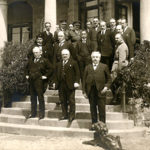Published May 30, 2008
Faith and Law
**Note: Click here to download a copy of this transcript with complete footnotes. **
A Faith & Law Lecture
Rayburn House Office Building
Washington, D.C., 30 May 2008
I’d like to thank Faith & Law for spoiling its hitherto spotless record of excellence by inviting me to present one of its lectures. As you know, Faith & Law lectures are supposed to help Congressional staff better understand the implications of a Christian calling to the public square.
I spent ten years working in several offices on this very floor in the Rayburn House Office Building. I began at age 26 (about the same as many of you) working for then-Congressman Jack Kemp, who was trying to convince Ronald Reagan to make the Kemp-Roth marginal income tax rate cuts the economic centerpiece of his 1980 presidential campaign. When Reagan took office, Kemp was elected chairman of the House Republican Conference [caucus], and I stayed with him through both of Reagan’s terms, among other things developing the Kemp-Kasten plan (the GOP prototype for the Tax Reform Act of 1986; the Democratic version was the Bradley-Gephardt plan). The first year I also got married and began re-converting from college atheism to Christianity, first as a Methodist and ultimately what used to be called a “practicing” Catholic; which means simply that I keep practicing because I still don’t have it right.
Improbably enough, this experience furnished the skills I needed to make a living in the private sector for the past two decades, mostly as an economic and financial market forecaster and consultant to Wall Street money managers (though occasionally government policymakers). Three years ago I also started the Economics and Ethics Program at the Ethics and Public Policy Center here in Washington, a think tank founded in 1976 with the unique mission of applying the Judeo-Christian tradition to American public policy.
Joe Manzari of Faith & Law helpfully suggested I update a theme I once presented at a Princeton conference on Faith and the Challenges of Secularism, which was titled “The Economist as Preacher vs. The Preacher as Economist.”
“The Economist as Preacher” was the title essay of a book by University of Chicago economist (and later Nobel laureate) George J. Stigler, an able economist, but also the one most responsible for what I call “Smythology”: the myth that Adam Smith either “invented” or is somehow indispensable to understanding economics.
“The Preacher as Economist” is Thomas Aquinas, the most famous member of the (Dominican) Order of Preachers, who integrated previously disconnected elements from Aristotle and Augustine into the first complete outline of economic theory.
More broadly, these are two different ways of understanding what it means to be an economist, and for that matter what it means to be a preacher.
I don’t have time to tell the fascinating story of Stigler’s own reversal of attitude toward the history of economic theory. In 1950, he was arguing that economic theory advances by becoming simpler, by explaining more of the facts, and above all, by posing “refutable implications.” But in 1955, he had begun to argue that great economists are not those whose ideas turn out to be right, but rather “those who influence the profession as a whole”; and that, since “new ideas are even harder to sell than new products,” to become influential, economists must necessarily use the “techniques of the huckster”: “repetition, inflated claims, and disproportionate emphases.” Stigler eventually called this new approach “the economist as preacher,” and identified it with Adam Smith, to whom he had previously given either little or disparaging attention. Rather than being someone trying to discover the truth about certain things, according to Stigler, “A scholar is an evangelist seeking to convert his learned brethren to the new enlightenment he is preaching.” In 1969, Stigler told his fellow economists, in effect, to “abandon HoPE.” That is, his contribution to the first issue of the journal History of Political Economy (HoPE) was an essay posing the question, “Does Economics Have a Useful Past?” which he essentially answered in the negative.
I must begin with an important but (thanks to Stigler) widely overlooked fact: There have been three phases so far in the history of economics, and the logical and mathematical structures of scholastic, classical and today’s “neoclassical” economics differ fundamentally. Most students and even professors of economics are unaware of this fact because, starting in 1972 at the University of Chicago, Stigler succeeded in the national campaign he started in 1954 to abolish the requirement that students of economics master its history before being granted a degree. This is why all of us, including or especially economists, require a brief, remedial history of economics.
What is economics about? It describes from one angle what we do all day. Jesus once noted–I interpret this as an astute empirical observation, not divine revelation–that since the days of Noah and Lot, humans have been doing, and until the end of the world presumably will be doing, four kinds of things. He gave these examples: “planting and building,” “buying and selling,” “marrying and being given in marriage,” and “eating and drinking” (Luke 18:27-28). In other words, we produce, exchange, give, and use our human and nonhuman goods.
That’s the usual order in which we act: producing, exchanging, distributing, and consuming. But in planning we follow a different order: first, For Whom we intend to provide, which we will express by the distribution of our goods among them; next What to provide to express our love for those persons; and finally How to provide those means–through production (almost always) and (usually) exchange. So economics is essentially a theory of providence: It describes how we provide for ourselves and the other persons we love, using scarce means that have alternate uses. But as we’ll see, it has also concerned alternative theories of divine providence, two of which are contradict both reason and Christian faith.
Scholastic “AAA” economics (1250-1776) began in the mid-13th century when Aquinas first integrated these four elements (production, exchange, distribution and consumption), all drawn from Aristotle and Augustine, to describe personal, domestic and political economy within scholastic natural law–all normatively measured by the Two Great Commandments: “You shall love God with all your heart” and “You shall love your neighbor as yourself.” The scholastic economic system is comprehensive, logically complete, can be stated mathematically, and is empirically verifiable.
The scholastic outline was taught at the highest university level for more than five centuries by Catholics and (after the Reformation) Protestants alike. Adam Smith himself was taught from Lutheran Samuel Pufendorf’s compendium On the Duty of Man and Citizen According to Natural Law, which as with Aquinas and the earlier scholastics, contains all four basic elements of economic theory, organized according to personal, domestic and political economy, and integrating normative with descriptive theory by the Two Great Commandments. The fact that Pufendorf was a Lutheran who wrote a critical history of the Catholic Church and that his theories were taught at the generally Calvinist University of Glasgow, demonstrates that the scholastic outline of economic theory was broadly known and accepted
by both Catholics and Protestants. Pufendorf was widely read in the American colonies and recommended for example by Alexander Hamilton, who had penned two-thirds of the Federalist papers and as first Treasury Secretary would reject Smith’s specific economic advice in the Wealth of Nations to the United States.
Classical economics (1776-1871) began when Adam Smith, trying to explain what he called “division of labor” using production and exchange alone, chopped the four scholastic elements to two: dropping Augustine’s theory of utility (which describes consumption) and replacing both Augustine’s theory of personal distribution and Aristotle’s theory of social distribution with the mere assumption that everyone is motivated by self-love. This is how classical economics began with only two elements.
Today’s neoclassical economics (1871-c.2000) began when three economists dissatisfied with the failure of classical predictions independently but almost simultaneously reinvented the theory of utility, starting its reintegration with the theories of production and exchange. Personal gifts and distributive justice were both central to scholastic economic theory, early and late. Yet they are not taught in any neoclassical school (except by claiming them to be disguised consumption, production, or exchanges).
In a forthcoming book, I predict that Neoscholastic economics (c.2000–?) will revolutionize economics once again in coming decades by replacing its lost cornerstone, the theory of distribution: simply because, as with the theory of utility, including the element does a far better job of empirical description.
In understanding Adam Smith, therefore, we get off on the wrong foot if we begin by asking, “What did Adam Smith add to economic theory?” As Joseph Schumpeter concluded in his History of Economic Analysis, “The fact is that the Wealth of Nations does not contain a single analytic idea, principle or method that was entirely new in 1776.”
The real question is, “Why did Adam Smith subtract what he did from economic theory–and why was this subtraction popular for nearly a century?” The short answer is that this narrowing of the range of economic theory allowed classical economists after Smith to concentrate on developing the two elements he retained–production and equilibrium–to describe the increasingly obvious fact of economic growth. Later neoclassical economists found it necessary to abandon Smith’s revised outline for three related reasons: it made economists who used it unable to answer some important questions, led them to make empirical predictions that turned out to be spectacularly wrong about others, and fostered Karl Marx’s disastrously erroneous economic analysis.
Moral Newtonianism, philosophical Stoicism, and rhetorical Sophistry.
There are three keys to understanding Smith, both as a philosopher and as an economist: his moral Newtonianism, his philosophical Stoicism, and his Sophistical view of rhetoric.
First, Smith was in friendly competition with his older friend David Hume to do for moral philosophy what he believed Isaac Newton had done for natural science: to reduce all its phenomena to a single familiar principle, like gravity. He was always aiming, as he put it in an unpublished manuscript, “to see the phenomena which we reckoned the most unaccountable all deduced from some principle (commonly a well-known) and all united in one chain.” He wanted an economic system with one basic element, not four.
Second, having rejected his Christian baptism well before writing the Wealth of Nations, Smith was a wholehearted convert to the ancient Stoic philosophy–and Stoics are pantheists.
There are two ways in which the providence of Stoic pantheism differs from the biblically orthodox version of Augustine and Aquinas. First, the Stoic god is not a creator, but the world-soul of an eternal and uncreated universe that goes through endless identical cycles of expansion and contraction. Second, it necessarily follows that humans are not creatures endowed with free will, but rather appendages of God fated to do everything they do, good or bad. According to Augustine’s more logically consistent theory of providence, the order in markets and society comes entirely from the virtue (itself a kind of order) that remains even in bad people as long as they exist.
Finally, Smith was much more proficient (and interested) in rhetoric than in logical, systematic analysis. When first hired by the University of Glasgow as Professor of Logic (he later became Professor of Moral Philosophy), he immediately changed the course to teach rhetoric instead of the prescribed logic and metaphysics. Moreover, as his lectures and unpublished papers make clear, Smith disagreed fundamentally with Aristotle about the nature of rhetoric.
According to Aristotle, the purpose of rhetoric “is not to persuade, but to discover the available means of persuasion in a given case.” Why? “In Rhetoric, as in Dialectic, we should be able to argue on either side of a question; not with a view to putting both sides into practice–we must not advocate evil–but in order that no aspect of the case may escape us, and that if our opponents make unfair use of the arguments, we may be able to refute them.”
Smith’s view of rhetoric, in contrast, resembled that of the Sophists who opposed Plato and Aristotle, by placing a higher value on whether a statement is useful to the speaker than whether it is an accurate description of reality. Smith taught his students, “The Rhetoricall [discourse] again endeavours by all means to perswade us; and for this purpose magnifies all the arguments on one side and diminishes or conceals those that might be brought on the side contrary to that which it is designed that we should favour.” And this, as we will see, is exactly how Smith presents his economic theory.
Smith’s moral Newtonianism induced him to oversimplify the economic theory he had inherited. In his earlier Theory of Moral Sentiments, he tried to reduce all moral philosophy to the single sentiment of sympathy; Smith attempted in the Wealth of Nations to explain all economic behavior by the single principle of labor–but he never achieved a theory that could reconcile these two.
Smith’s philosophical Stoicism accounts for his rejection of some elements of the scholastic outline and retention of others. In the Theory of Moral Sentiments, Smith rejected the scholastic theories of final distribution and utility on the grounds that they presume rational, purposive behavior. In Smith’s view–and here the pantheism becomes apparent–decisions about ends and means, rather than being decided by human beings, are ultimately dictated to them by an inscrutable Stoic version of providence, which engages the vast majority of humankind in a “deception” about the “real satisfaction” afforded by economic goods. By systematically manipulating human emotion, the Stoic Author of Nature supposedly “rouses and keeps in continual motion the industry of mankind,” luring most people (except the Stoic sage) into vice. The rich are seduced by greed into “selfishness and rapacity,” while the “mob of mankind” is corrupted by envy of the rich. Yet all is for the best. To satisfy their “vain and insatiable desires,” the rich few must employ the envious mob, and so “they are led by an invisible hand to make nearly the same distribution of the necessaries of life, which would have been made, had the earth been divided into equal portions among its inhabitants.”
Smith’s famous “invisible hand,” therefore, is not a summary of his economic analysis; it is a rhetorical plug that he substitutes where the two elements of economic analysis that he eliminated are required: the scholastic theories of final distribution and utility. Moreover, “invisible hand” is a thoroughly apt metaphor: his philosophy reduces humans to puppets compelled to
act by hidden manipulation.
Since Smith treats final distribution and utility by omission rather than revision, it is easy to overlook their significance when we come upon the passages in the Wealth of Nations in which their omission is signaled.
Smith’s elimination of Augustine’s theory of personal distribution from the outline of economic theory is signaled in the passage that includes his famous declaration: “It is not from the benevolence of the butcher, the brewer, or the baker, that we expect our dinner, but from their regard to their own interest. We address ourselves not to their humanity but to their self-love, and never talk to them of our necessities but of their advantages.”
In Augustine’s theory, the main reason the brewer or baker doesn’t serve his customers from beneficence is not exclusive self-love, but rather the fact of scarcity: if the baker shared his bread equally with every customer instead of charging for it, he would leave himself and his family too little to live on. Augustine’s theory also explains why the brewer or baker shares with his family or friends but not with his business customers: he loves his customers only with benevolence (wishing good to them) with both benevolence and beneficence (doing good to them). He sells his product to customers to earn the means to provide for himself and the rest of his family. Augustine’s theory of personal distribution explains the essential difference between a gift and an exchange, and provides a measure of how far each of us actually is motivated by self-love and how much by love of neighbor. By treating self-love as the only motive of economic behavior, Smith replaced Augustine’s empirically verifiable theory of personal distribution with an arbitrary and often false assumption: that no one ever shares his wealth with anyone else. Both classical and neoclassical economics implicitly assume that we’ve always already made our choice of persons–and have always chosen “number one”: ourselves.
Smith fails to grapple with the fact that charitable behavior simply does not fit into a theory that reduces all human transactions to exchange and self-love. He never explains why customers never expect their dinner from the butcher’s beneficence, yet his friends occasionally and his children always expect it.
Shortly after dismissing the scholastic theory of final distribution with this assertion about universal self-love, Smith dismisses the scholastic theory of utility by posing what is sometimes called the “paradox of value.” Without offering a solution to this apparent paradox, Smith rhetorically throws up his hands and abandons discussion of value in use, as if the concept were absurd.
This is a case in which Smith “endeavours by all means to perswade us; and for this purpose magnifies all the arguments on one side and diminishes or conceals those that might be brought on the side contrary to that which it is designed that we should favour.” Though Smith twitted Hume in the Theory of Moral Sentiments for retaining Augustine’s theory of utility, students’ lecture notes show that Smith continued teaching it for several years in his own university lectures, posing the same paradox involving diamonds and water he later raised in Wealth of Nations, and easily resolved it along scholastic lines, explaining the difference in value by the combination of utility and scarcity.
The Choice of 1776.
By far the most influential piece of “Smythology” was Milton Friedman’s argument in Free to Choose (1980), linking Adam Smith’s philosophy with the meaning of the American Declaration of Independence: “The story of the United States is the story of an economic miracle and a political miracle that was made possible by the translation into practice of two sets of ideas–both, by a curious coincidence published in the same year, 1776.” According to Friedman, “the fundamental principles of our system [are] both the economic principles of Adam Smith…and the political principles expressed by Thomas Jefferson.”
I also found this persuasive, until I discovered that the “choice of 1776” was actually a divergence, not a convergence of those philosophical views.
When the Apostle Paul preached in the marketplace of Athens (probably in 51 A.D.), he prefaced the Gospel with a Biblically orthodox version of natural law that he adapted from Greco-Roman philosophy. The evangelist Luke tells us that “some Epicurean and Stoic philosophers argued with him” (Acts 17:18). The same dispute has continued over the centuries among (neo)scholastic, classical and neoclassical economists.
In the scholastic natural law, economics is a theory of rational providence, describing how we “rational,” “matrimonial” and “political animals” choose both persons as “ends,” expressed by our personal and collective gifts, and the scarce means to be used by or for those persons, made real through production and exchange. By dropping the scholastic economic theories of distribution and consumption that he had been learned, Smith expressed the Stoic pantheism that viewed the universe “to be itself a Divinity, an Animal” with God as its immanent soul, so that sentimental humans choose neither ends nor means rationally. By restoring consumption (the choice of means) but not distribution (the choice of ends), neoclassical economics expressed the Epicurean materialism that claims humans somehow evolved in an uncreated universe as semi-rational or clever animals: highly adept at calculating means but having no choice but self-gratification, since (in Hume’s words) “reason is, and ought only to be, the slave of the passions.” Or as Ludwig von Mises would later put it, “The power to choose whether my actions and conduct shall serve myself or my fellow beings is not given to me.” The scholastic thinkers understood that it is.
A third event occurred in 1776, which crystallized the three-way debate and its implications for Christian faith: the death of David Hume. In a letter dated August 14, 1776, Smith wrote: “Poor David Hume is dying very fast, but with great chearfulness and good humour and with more real resignation to the necessary course of things, than any Whining Christian ever dyed with pretended resignation to the Will of God.”
The notion that “all men are by nature equal” is an old one. We find it in exactly, or almost exactly, those words in Plato, Zeno of Citium (the founder of Stoicism), Thomas Hobbes, Algernon Sidney, and John Locke. But to say “all men are created equal” was a much more specific, and one might say, inspired formulation. In itself, creation ex nihilo is a philosophical rather than religious idea. But it does not exist anywhere in ancient pagan philosophy or in the world-views implicit in classical and neoclassical economic theory. Smith’s Providence is the great “Conductor” or “Superintendant” of the universe, but not its Creator, and in the Epicurean philosophy there is no god and thus no providence–only (unexplained) matter and chance.
Therefore, in one thing at least, we are not “free to choose”: we can either have all men “created equal” as in the Declaration of Independence, or Smith’s “invisible hand” of Stoic pantheism, manipulating humans as God’s puppets–but not both. All men cannot be “created equal” unless all men are “created.”









